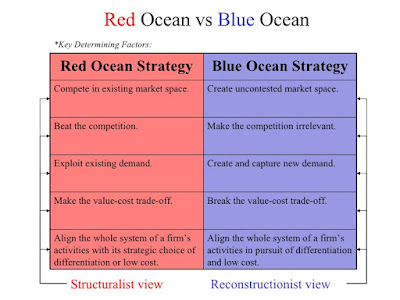Showing posts with label book. Show all posts
Showing posts with label book. Show all posts
How to make competitors irrelevant
Nowadays many business owners struggle to impress the consumers with their products in the endless sea of competition. Renee Mauborgne and W Chan Kim bring salvation to all of those businesses, experiencing frustration and inability to outcompete the other players on the market.
The book we are going to discuss today is Blue Ocean Strategy, Expanded Edition and we highly recommend it as the ideas and examples are mandatory knowledge for everyone doing business in nowadays oversaturated markets.
An overall belief is: if a business owner wants to be successful the business needs to beat the competition. But Renee Mauborgne and W Chan Kim believe that striving to beat the competition in an established market is a very unwise business strategy, especially if your business tries to compete over an established market (e.g. fast food, health & beauty, fitness markets).
If your business is trying to outperform the competition you are adopting what the authors call “Red ocean business strategy”. Nowadays, thanks to globalization, the widespread access to information, and the major improvements in technology it is very easy for business owners to try their luck into an established market. The consequences are vastly oversaturated markets, and the only business strategy for success in such markets is to compete with the other businesses for market share. Those battles (metaphorically) turn the waters bloody and this is where the term “Red ocean” comes from.
The alternative for the business owners is to sail past the “red oceans” and focus on searching and creating a “Blue ocean business strategy” for untapped market potential. According to the authors, this will greatly increase the new business’ chances of survival and profitability. The authors studied about 110 new businesses, across more than 30 different industries. About 100 out of those businesses adopted “Red ocean business strategy” and only a small number of businesses dared to adopt “Blue ocean strategy” to avoid competition. They searched for (and created) new markets to dominate. After some time, the authors measured the collective profits of all the companies and found out, that the “Red ocean” businesses only accounted for about 40% of the total profits, while the “Blue ocean” businesses managed to generate 60% of the total profits.
Renee Mauborgne and W Chan Kim studied the companies extensively for years and discovered that the “Blue ocean” businesses dominated their respective markets for 10 to 15 years after their initial launch, while many of the “Red ocean” businesses run out of business after a couple of years (or sooner).
As a business owner, you are probably asking “Ok, how could my business use blue ocean strategy and make competitors irrelevant?”. We will provide some examples of companies and how they did it.
Casella wines
They used a “Blue ocean strategy” to find an uncontested ocean of opportunity and dominate the market for over a decade, by creating a new category of wine, and become the best-selling wine in Australian and United States history.
Casella wines set out to create a successful new wine product. They knew the market is oversaturated and competing with existing wine brands in the traditional manner would be extremely difficult. If they have chosen a “Red ocean strategy” they would need to establish the brand over the span of several years and hope to win several awards along the way, hoping to gain the favor of existing wine drinkers. Those should have been a lot of investments leading to some very uncertain results.
Casella wines decided to take a different approach instead, and not only focusing on wine drinkers like most wine businesses. They mainly focused on beer and cocktail drinkers’ consumers in adjacent markets of other alcoholic beverages, who either infrequently drank wine or avoided wine altogether. They approached these non-wine-customers and ask them a few questions. E.g.: why did they avoid drinking wine and what was specifically discouraging them from drinking wine. These non-wine-customers shared many of the same reasons for avoiding wine. One of the most important reasons was that purchasing wine is intimidating, and having to choose from such a large variety of wines makes the process of purchasing wine overwhelming and time-consuming. Another important business discovery was that most non-wine-drinkers find wine unpleasant to drink – as it is either too bitter, harsh, or too sweet. Another reason was that those non-consumers believed wine is simply not so much fun to drink, compared to beer, cocktails, and other beverages. The wine seemed too fancy, traditional, and elitist.
Casella wines business accepted the challenge and set out to make a wine that would appeal to
these frustrated consumers of non-wine-drinkers. At the same time, they kept producing a wine that would be considered high quality to most wine drinkers.
The newborn wine product was called ‘Yellowtail’. The non-wine-drinkers found it very easy to purchase, drink, and enjoy. It was sweet enough to keep their palates fresh and keep them wanting more but not too sweet as to be associated with cheap and low-quality wine.
Casella wines had created a new category of wine that was fun, easy to drink, and relatively high
quality and ultimately caused a large portion of the non-wine-consumers to embrace the new category of wine. The new product provided incredible value; ‘Yellowtail’ was a high-quality innovative product at an incredibly good price. A price that was comparable with most beers and much cheaper than most of the cocktails.
The business strategy to create an innovative new product, while the same keeping costs low is what Renee Mauborgne and W Chan Kim call “value innovation” and it's at the heart of every “Blue ocean business”. To achieve value innovation and discover blue oceans of opportunity Casella wines adjusted four levers during the development of the ‘Yellowtail’ (eliminate, reduce raise, and create).
1. Eliminated the aging process of the ‘Yellowtail’ wine and saved money on oak barrels and storage costs.
2. Reduced the inventory to just two wines. They offered just a white Chardonnay and a red Shiraz. Operating at minimum inventory reduced the cost of their product, while simultaneously increasing the appeal to infrequent or non-wine-drinkers who valued something much simpler.
3. Casella wines raised the freshness and drinkability of their ‘Yellowtail’ wine, so it was easy on the palate like beer and cocktails.
4. Incorporating practices from adjacent markets like the beer industry Casella wines created a new wine label that was simple and somewhat adventurous like many beer labels. The label just had a picture of a kangaroo and stated that the product was from Australia. Casella wines removed information about the age of the wine and there was not any fancy terminology that stressed the art and science of winemaking and confusing the consumers. Casella wines also came up with a bottle that could be used by both white and red wine. The first of its kind, but it was something that the beer industry had been doing for years.
Playing with these four levers allowed Casella wines to create its own wine category of fun, unintimidating, easy-drinking wine and it attracted a whole new group of customers to the wine market in an area of the market that Casella wines could dominate for years to come and due to their “Blue ocean business strategy” they created the category of fun, easy-drinking wine they had a huge head start on the competition, making it extremely hard for competitors to steal any market share from Casella wines.
--
This is the power of “Blue ocean strategy” and there are several businesses which have used the strategy to dominate their market.
Another blue ocean business example is ‘5-hour energy’ (or the alternative Moose Juice Energy Shots)
It is a mini energy drink that you see on the counters of almost every convenience store in the US. ‘5-hour energy’ created the new energy drink market of two bottles, and it maintained a 93% market share of that market category despite competition from major competitors like Coke and Red Bull. Because the business owner created the category and got out to a huge lead on future competitors ‘5-hour energy’ continued to dominate that category nowadays.
if you, as a business owner are interested in finding blue waters for your next business idea and try dominating a market niche for years start by focusing on 1. the frustrations of customers outside of your current market space and 2. look at existing products or services within the market and ask yourself:
1. What can my business eliminate?
2. What can my business reduce?
3. What can my business raise?
4. What can my business incorporate?
… to create something new and attract infrequent or non-current customers.
By pulling these four levers any business owner can gradually develop a product that defies the status quo and creates a new product category that the business will dominate for years. As a business owner, you should stop focusing on how you could beat the competition and start focusing on how you can make the competition irrelevant. That’s what every business owner should learn from the “Blue ocean business strategies”, described in the book Blue Ocean Strategy, Expanded Edition
p.s. As usual, if you would like to support the 'Money Questions' blog - please buy the book and other linked products, using our affiliate links.
What is a good business strategy
Yesterday, a business owner asked us for advice on business strategy over our FB page. He wondered what a good business strategy is, and what business strategy should his team adopt, for his company to be more successful and dominate the market. He liked our easy to read and comprehend articles and asked to keep the answer simple and easy to understand.
And here we go – answering “What is a good business strategy and what strategy your team is to adopt for your business to be more successful?”
We are going to explain one of the best models out there, described in the book The Competitive Strategy: Techniques for Analyzing Industries and Competitors
Michael Porter published his famous book in 1980 and most successful companies have used it as the number one guide to dominate markets and smash competitors with style.
There are 3 major elements defining your business strategy, spread over two dimensions. Based on the reach of the market those are: broad or narrow (niche) markets; and based on competitive advantage there are low cost (price) and/or differentiation.
1. In the top left corner, we have the "Cost leadership strategy". Companies, adopting the strategy aim to become the lowest-priced provider for a broad customer base.
To achieve the goal, the business strategy outlines items such as: efficient and lean production methods; closer relationship with suppliers (to get discounts); investing in cutting edge technology to reduce costs; and efficient distribution network.
Examples of such companies are RyanAir, Amazon, and Poundland. All of them tend to operate over large-broad markets and provide the lowest possible price for the largest customer base.
2. In the top right corner, we have the "Differentiation strategy". It's characteristical for the companies doing something completely different and unique and providing unique service and experience to charge premium rates and have the customers pay more.
It is achieved by delivering exceptional quality; astonishing brand value, while at the same time the level of distribution remains wide enough to cover the entire market.
Examples of companies adopting entirely "Differentiation" business models and strategies are Apple, Mercedes-Benz, and Disney parks and resorts. They create unique experiences for their customers and charge high to profit out of them.
3. In the bottom left we have the "Cost focus strategy" in a narrow market. It is used by companies to dominate very niche markets purely by offering the best possible value (in terms of costs) and price.
They achieve this by specific innovations, cost reduction techniques, complete automatization, and removal of anything that generates additional cost.
One of the most successful companies using the cost focus business strategy is Aldi. They offer a very limited variety of products in unappealing warehouses, with a reduced number of employees, and at the same time offer usually the best prices possible. Another completely different example is IKEA, offering stylish and well-designed furniture at a very reasonable price, by producing the materials abroad, and keep the service level at a minimum.
4. The last (bottom-right) quadrant contains the "Differentiation focus strategy". This strategy is characterized by the idea of using uniqueness and differentiation in a niche and focused market.
This is achieved by a high level of innovation, specific and focused customer service and features, valued by a small group of wealthy enthusiasts.
Examples of companies, using such business strategies, are Rolls Royce, Harley-Davidson, and Ducati. They all offer unique experiences and features in their products and charge premium prices for them. On the other side, there are companies like Costa Drive-Thru. They offer the same high-level quality coffee and tea for customers who do not have the time and availability to sit down and would like to have it on the move and would pay for the pleasure.
--
So, the bottom line is – choose carefully the business strategy you would elaborate and follow to match your business vision and goals best. Define if you are aiming for a niche market or broad audience. Also focus on either providing some unique and distinguishable experience, feature, or services – to be able to charge premium, or if your product is more on the mainstream side, you would need to provide it in a cost-efficient manner, lowering the price. The worst option for a business strategy is to stay somewhere in the middle and try to serve customers in all the quadrants. Companies, struggling in terms of business strategy models are Yahoo, BlackBerry, Nokia, Morrisons, Sony. They all failed to innovate at such a level to end up with a unique and differentiating product or service, while at the same time were not able to reduce the costs at such levels to be able to offer the best possible prices on the market.
Money Master the Game: 7 Simple Steps to Financial Freedom (key points)
Tony Robbins created an absolute masterpiece with his book Money Master the Game: 7 Simple Steps to Financial Freedom
Here is a short review, outlining the most important steps
1. Decide to master the financial area of your life
- commit to self-discipline and mastery over your financial state
- decide to become an investor, and not just a consumer
- commit a percentage of your income towards your own freedom
- fund yourself and put the money aside and don't touch it
- learn the power of compounding can grow your funds
- understand the financial state is a game and the game is rigged
- if you don’t know the rules of the game – the house will always win
2. Learn the nine myths related to money
- important myth is that fees are not important. In fact, fees can result in millions of dollars difference
- be aware of the myth that that mutual funds beat the market
- another myth to consider is that your broker is your friend. The broker is not legally bound to act in your best interest, so if you are seeking financial advice it might be better to go to fiduciary. This guy is legally bound to act in your best interest.
- It is a myth that you got to take a big risk for a big reward
3. Define a price to your dreams
- be specific as to how much money you want
- understand what kind of income you would play for
- Tony defines 5 levels of the financial state
1. financial security – when you are just surviving with your income
2. financial vitality – where you have some money to put aside
3. financial independence – you don’t need to work for another person anymore
4. financial freedom – accomplishing all your bucket lists and living the life of your dreams
5. absolute freedom – you can do whatever you want and have enough money to contribute to the success of the others
- in order to achieve the level of money, you need to become a more valuable person
- there are 5 strategies to accelerate the process of gathering more money and funding your dreams
1. earn extra money and invest the excess
2. reduce the number of fees and taxes payed
3. save more money and invest the savings
4. maximize the return on investment
5. change your lifestyle and invest the difference
4. Learn how to invest
- assets allocation is the key to your successful investing, and it goes way beyond owning just a variety of stocks
- it is more about owning a variety of unrelated asset classes e.g. stocks, real estate, businesses
5. Create a lifetime supply of income
- start accumulating a massive amount of wealth by investing in low-cost, tax-advantaged well-allocated investments
- follow by converting your wealth into an annuity that pays you a consistent income every single month for life
6. Invest like the richest people
- follow the four important principles
1. do not lose money
2. seek asymmetric risk class reward which is high-reward - low-risk
3. anticipate financial disasters and diversify your investment
4. never stop learning, stay hungry and motivated to consistently improve
- Tony acknowledges the most successful people he's ever met had a relentless pursuit for knowledge
7. Live the rich life, and enjoy the abundance in your life full of money and achieved dreams
- pursue satisfying the six basic human needs
1. the need for certainty
2. the need for uncertainty
3. the need for love and connection
4. the need for contribution
5. the need for significance
6. the need for growth
- the most important and fulfilling need is to be sure to contribute to the happiness of the others. Being the richest man in the graveyard is a wasted life. The secret to living is giving.
Please support the blog and Tony Robbins by purchasing the book Money Master the Game: 7 Simple Steps to Financial Freedom
Subscribe to:
Comments
(
Atom
)





